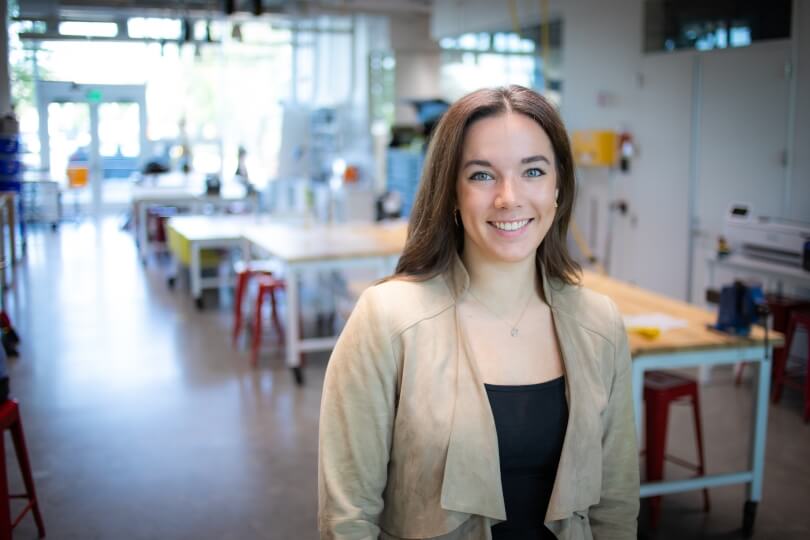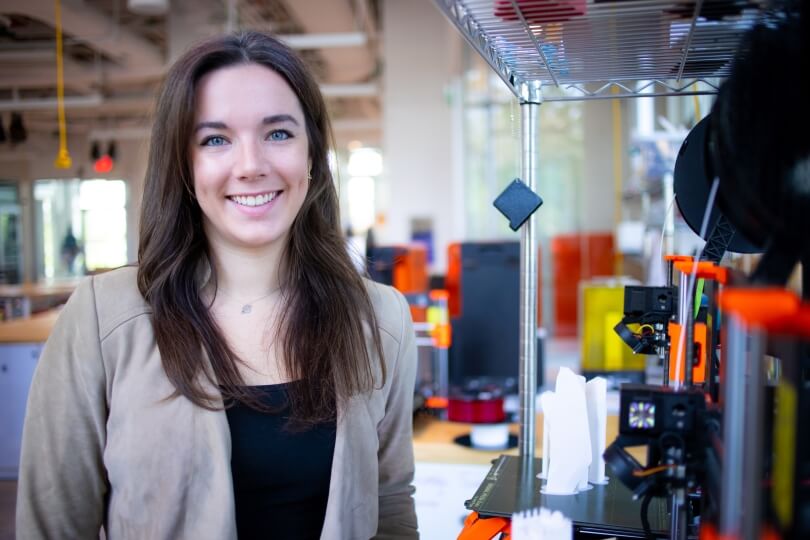Kate Sweeney, M.S./M.B.A. '23 (Eliza Grinnell/SEAS)
Space exploration has produced so many technologies that are now part of everyday life. Polymers in space suits became the flame-retardant suits used by firefighters. Miniature imaging systems became the cameras used in smartphones. Even the soles of modern athletic shoes have their origins in the shock-absorbing rubber in astronaut helmets.
Kate Sweeney has always been fascinated by how space technology can be used to improve people’s lives back on Earth. Sweeney, who is about to complete her M.S./M.B.A., offered jointly by the Harvard John A. Paulson School of Engineering and Applied Sciences (SEAS) and Harvard Business School, will soon head to SpaceX, where she’ll work in the direct-to-cell connectivity department. Along with enabling normal cell phone features such as text messaging and phone calls, that technology uses the communication between cell phones and satellites for remote search-and-rescue, especially in rural settings with otherwise limited connectivity.
“Space is the only truly shared resource we have, because you can’t stick a flag in orbit and claim anything,” Sweeney said. “It’s a really powerful tool for the betterment of society.”
After earning a bachelor’s degree in mechanical engineering from MIT, Sweeney worked for a pair of technology start-ups in the three years before coming to Harvard. Neither experience ended the way she wanted: one company laid her off after going bankrupt when the COVID-19 pandemic began in March 2020, while the other struggled to manage its finances in order to scale up. Those two jobs spurred Sweeney to join the M.S./M.B.A. program in order to add entrepreneurship to her engineering skills.
“I realized I didn’t want to just assume that if someday I was in the decision making room and was the one with the power, I would magically know how to bridge the gap between technology and business strategy,” she said. “Knowing how to build out a financial forecast, carry out a discounted cash flow and do all of those financial steps in modeling and business has been really helpful. If I were to propose building a startup, I’ll know how much cash I’ll need on hand, and knowing how to project the success or failure of a business has been really helpful.”
Even while honing her entrepreneurial skills, Sweeney continued to build new machines. Since coming to Harvard, she’s designed a fleet of spacecraft to clear small debris from low-Earth orbit, a robotic plant to mimic users’ posture and help prevent back pain, and a satellite to conduct real-time measurements around the sun for better space weather predictions.
“This whole program has made me more willing to explore options, say ‘yes’ to things, and understand the power of creativity in facing tough problems,” Sweeney said. “The classroom experience on the case side at HBS has helped me become a mini-expert in a lot of different subjects day to day, and on the SEAS side the opportunity to actually build and develop products has been such a cool exercise in the power of creativity and solving tough problems.”
Building a similar potentially life-saving machine got Sweeney into engineering in the first place. While taking a technology and engineering class at her Massachusetts high school, she worked on a search-and-rescue vehicle that could help divers search for people who’d fallen into frozen lakes. Her team presented the project at MIT and even to President Obama at the White House Science Fair, and her love for engineering only grew from there.
“Engineering wasn’t just problems on a board, but building things to actually help people,” she said. “It’s really dangerous for ice divers to have to go in to see if someone has fallen through. They can lose their dive line, get stuck under the ice. It’s a low-visibility environment and really bad to go into without knowing if there’s something down there to look for.”
Wanting to use aerospace technology to benefit society, Kate Sweeney will soon head to SpaceX, where she’ll work in the direct-to-cell connectivity department. (Eliza Grinnell/SEAS)
Sweeney’s upcoming job will bring together all her interests in a way that none of her previous job experiences could. She was an undergraduate intern on the launch team at SpaceX, but that lacked the real-world benefits she wanted. She interned in the engineering project management program at Apple last summer, but that job lacked a real connection to space.
“Apple was a really cool opportunity to build consumer hardware in an environment that had the resources to teach me really well and the freedom, even as an intern, to own a project,” she said. “It was thinking critically with both sides of my degree, and also a lot of financial modeling, which wasn’t something I’d been exposed to in my fulltime job as an engineer. Proposing a budget to directors and justifying why you need each purchase requires not only good financial skills to make sure you’re not overpaying, but also good engineering skills to know what you need in the first place.”
Sweeney finished her time at Harvard with a capstone project focused around helping companies more sustainably manage their water resources. Like all her favorite projects, it has the potential to help people on Earth using technology designed for space.
“I’m using my interest in space technology by assessing how satellite imagery could combine with machine learning and artificial intelligence to predict water usage,” Sweeney said. “I’ve learned so much, and to be able to sharpen both my engineering and entrepreneurial skills at the same time has been really good.”
Press Contact
Matt Goisman | mgoisman@g.harvard.edu

